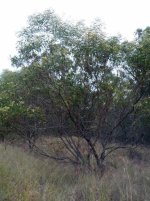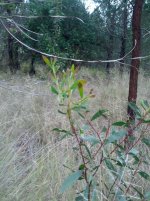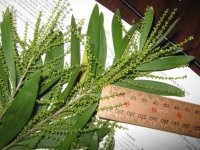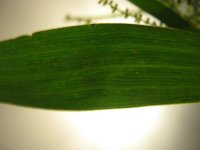-
Members of the previous forum can retrieve their temporary password here, (login and check your PM).
You are using an out of date browser. It may not display this or other websites correctly.
You should upgrade or use an alternative browser.
You should upgrade or use an alternative browser.
Botany Acacia and Mimosa Identification Thread
- Thread starter endlessness
- Start date
Growing logs with advice and results.
Migrated topic.
Gowpen said:WOW.... what can I say, Only.. that looks way more than personal use... AND its from a tree that is not even identified.
Quote.
I must say I agree..this is highly unethical harvesting practices and I dont think many here will support the practice.
Best to always make sure the tree you want to harvest is the tree you want..stripping bark from a tree like that in many cases can cause the tree to slowly die due to disease...especially avoid ring barking trees even if they are the right trees, no tree is a right tree to ringbark.
Always learn about the tree first, often branch bark can be used instead of trunk bark which is far less destructive to the tree..sometimes phyllodes can be even used. Stripping bark like that far down the trunk close to the roots is definatly one of the most destructive ways to harvest for the tree.
Yes we all agree that unethical harvesting is bad, and that seemed like one example. He said he's sorry though, I hope this means he will from now on research more into sustainable harvesting, and help educating others on this topic so that his damage is compensated by the good he's gonna do, right, dhzer0? 
Do check the acacia information thread linked in the first post, it has good info on sustainable harvesting
Do check the acacia information thread linked in the first post, it has good info on sustainable harvesting
..yeah i think it's already all been said about that poor tree up there^..but understanding is what this site's about..
regarding the bi-pinnate acacia in the first post endlessness, there is a brief discussion of A. dealbata (which i think it is) here in the acacia info thread..the other similar australian bi-pinnate common internationally (along with A. decurrens) is A. mearnsii, but i don't think it is..to help differentiate between the 3 see #439 acacia info and #438 by wira before it..
.
as for the south african shots in post#7, the first really needs flowers/pods for ID..could be A. pycnantha..
the last shot is a good bet for A. cyclops (again, flowers needed for ID)
.
regarding the bi-pinnate acacia in the first post endlessness, there is a brief discussion of A. dealbata (which i think it is) here in the acacia info thread..the other similar australian bi-pinnate common internationally (along with A. decurrens) is A. mearnsii, but i don't think it is..to help differentiate between the 3 see #439 acacia info and #438 by wira before it..
.
as for the south african shots in post#7, the first really needs flowers/pods for ID..could be A. pycnantha..
the last shot is a good bet for A. cyclops (again, flowers needed for ID)
.
Hi guys quick help with an acacia ID from near Dalby Queensland. Growing right next to Acacia harpophylla.
It caught my eye due to the red stems and red hue on immature leaves. Appears to reach a height of 4-5m, branching early. Currently flowering with a yellow brush. Phyllode - 3 main veins, seemingly 1 pore 2-3mm from base.
It caught my eye due to the red stems and red hue on immature leaves. Appears to reach a height of 4-5m, branching early. Currently flowering with a yellow brush. Phyllode - 3 main veins, seemingly 1 pore 2-3mm from base.
Attachments
..hi austra..based on your area and the photos i'd say it's either A. leiocalyx or A. concurrens (also p.18 )..though there are are a few very similar related species in Qld..
btw, a reminder there's now a new ACACIA ID THREAD, so let's direct future IDs there..
hopefully a way to move other ID posts without ruining the index references in this thread will be found soon..
.
Growpen wrote:
.
btw, a reminder there's now a new ACACIA ID THREAD, so let's direct future IDs there..
hopefully a way to move other ID posts without ruining the index references in this thread will be found soon..
.
Growpen wrote:
..the exact mechanisms of why crystals form the shapes they do are on the not fully understood surrealistic borderline between physics and chemistry..crystalization has an inherent mystery about it..Why do the crystals clump in one or 2 spots ?? is there some sort of communication going on or magnatism ? Interesting ... just a thought..
.
first three are suspected floribunda..
the next couple are of an acacia i found in warrendyte.. i suspected it may be acacia mucronata var. longifolia but need confirmation





the next couple are of an acacia i found in warrendyte.. i suspected it may be acacia mucronata var. longifolia but need confirmation





Well, I went around town today and took various pictures of acacias and what I believe to be acacias, but it's hard to tell when they aren't flowering.
I've got them all on flickr due to the amount of photos I took and the size of each image. Each plant has it's own set of images (ie. the first plant is 1_XXX, the second 2_XXX, etc). Well, at least for the ones that I can remember. I should have named them as I was taking them.
Oh well, on to the pictures
hxxp://www.flickr.com/photos/65961201@N06/
And sorry if I'm not supposed to post links, in which case, I'll slightly edit the link.
Cheers
I've got them all on flickr due to the amount of photos I took and the size of each image. Each plant has it's own set of images (ie. the first plant is 1_XXX, the second 2_XXX, etc). Well, at least for the ones that I can remember. I should have named them as I was taking them.
Oh well, on to the pictures
hxxp://www.flickr.com/photos/65961201@N06/
And sorry if I'm not supposed to post links, in which case, I'll slightly edit the link.
Cheers
..your ID skills are getting good bricklaya..yes I think the first is floribunda..the second is almost certainly mucronata spp. Longifolia..
thanks for the encouragement nen.. really enjoying researching these divine plants. they are one of a kind. isnt it funny how you can just tell an acacia.. they vary so much in appearance, yet theres just this vibe to them
ok.. well just got back from a nice walk around armidale  And i have many trees that i'm keen to know the name of..
And i have many trees that i'm keen to know the name of..
these first two pictures are of a beautiful acacia i found on the outskirts of town.. i was pretty taken back by its vibe it had a really beautiful feel to it.. never seen one of these before, and keen to test if i can be sure that there are many more about. i must say something about this tree resonated with me in quite a profound way.. so keen to get seeds for these guys


next couple photos are of an acacia i've seen all around armidale.. i have a feeling i may have seen these around vic as well but not 100%. it kind of has floribunda-like qualities though i'm certain it is not floribunda. unfortunately none of the acacias here are in flower at the moment


once again got a very powerful vibe from this tree in the next couple photos.. it actually reminded me of some photos of acuminata that i've seen, though i doubt it would be, being in new england NSW.. and the phyllodes looked bit different and didnt have the acuminate ends


i'll post more photos in the next post to make it a little less confusing
these first two pictures are of a beautiful acacia i found on the outskirts of town.. i was pretty taken back by its vibe it had a really beautiful feel to it.. never seen one of these before, and keen to test if i can be sure that there are many more about. i must say something about this tree resonated with me in quite a profound way.. so keen to get seeds for these guys


next couple photos are of an acacia i've seen all around armidale.. i have a feeling i may have seen these around vic as well but not 100%. it kind of has floribunda-like qualities though i'm certain it is not floribunda. unfortunately none of the acacias here are in flower at the moment


once again got a very powerful vibe from this tree in the next couple photos.. it actually reminded me of some photos of acuminata that i've seen, though i doubt it would be, being in new england NSW.. and the phyllodes looked bit different and didnt have the acuminate ends


i'll post more photos in the next post to make it a little less confusing
clueless on these next two


think this ones melanoxyn?

heres another couple the second one is the same species as the one i posted in the previous page
the second one is the same species as the one i posted in the previous page




think this ones melanoxyn?

heres another couple


also i'd just like to add that the floribunda's here in the new england are quite varied in their appearance from those in melbourne. shorter and wider phyllodes. i checked with the nursery too and they said that they were indeed floribunda. This species seems like it really varies depending on the location... the ones here have quite maidenii like qualities...i wonder if the two hybridise? took some photos of a couple today though they arent great shots so i might go take more tomorrow then upload more
endlessness said:The main possibilities that I came across are Acacia dealbata or Acacia decurrens, given the fact they are both in europe, and my amateur first look at how phyllodes and seedpod looks from internet image searches.
I collected a small amount of phyllodes, boiled in lemon water, filtered, will base and pull with some non-polar and test with TLC to see if there are any alkaloids later this week.
I'm no good with the bipinnate species but when I see similar things here, A. dealbata would be my first guess, too.
How did the TLC go?
By the way they are actually true leaves in the bipinnate forms (not phyllodes).
dtrypt said:my bet is on that being rooikrans...
Yep - it's certainly not A. obtusifolia or A. longifolia as suggested - those have rod-like inflorescences whereas the pic shows ball-like flower buds.
dhzer0 said:Do you know if there are any alkaloids in rooikrans?? and the percentage of DMT in the different parts of the tree?
thanx
have a look at this thread
rookrans is A. cyclops.
OK, here's one I need help on...
... found in cultivation in central Vic, high rainfall area (Great Divide).
It has all the features of A. longifolia, except the flower spikes are 50-70 mm in length, I can't see any glands, the veins are only occasionally anastomatising, flower spikes seem to come off randomly, not only at axils and not always singly or in pairs, and it was a small tree about 3-4 m high. I saw another one about 4-5 m high also in town, did not get a sample but could well be the same tree.
Any clues?
... found in cultivation in central Vic, high rainfall area (Great Divide).
It has all the features of A. longifolia, except the flower spikes are 50-70 mm in length, I can't see any glands, the veins are only occasionally anastomatising, flower spikes seem to come off randomly, not only at axils and not always singly or in pairs, and it was a small tree about 3-4 m high. I saw another one about 4-5 m high also in town, did not get a sample but could well be the same tree.
Any clues?
Attachments
^..r2pi..i'd say it's a form of longifolia var. sophorae, though the spikes are a little long..hmm..finished flowers plus pod needed..interesting..
..hey, bricklaya..some of these trees look very promising..
i've been very busy lately, and full ID requires a lot of comparision/cross-checking and detail..
but for now, the last pic could be A. nerifolia (does it have a prominent central nerve on the phyllode?)
2nd last may be a form of A. saligna, but need pods and more time..
3rd last probably a form of A. melanoxylon, as you suggested..before that could be the fairly rare A. orites, which has small amounts unknown alkaloid, probably a ß-carb (own observations), but it's only found at 4-5 quite disjunct locations (may be as rare as A. phlebophylla)
..the last pics in the earlier post i have no idea right now, but the first couple look like A. complanata (N-methyl-tetrahydroharman main alkaloid 0.3% leaf in 1 formal test)
..be great to hear of some tests on some of these..
..hey, bricklaya..some of these trees look very promising..
i've been very busy lately, and full ID requires a lot of comparision/cross-checking and detail..
but for now, the last pic could be A. nerifolia (does it have a prominent central nerve on the phyllode?)
2nd last may be a form of A. saligna, but need pods and more time..
3rd last probably a form of A. melanoxylon, as you suggested..before that could be the fairly rare A. orites, which has small amounts unknown alkaloid, probably a ß-carb (own observations), but it's only found at 4-5 quite disjunct locations (may be as rare as A. phlebophylla)
..the last pics in the earlier post i have no idea right now, but the first couple look like A. complanata (N-methyl-tetrahydroharman main alkaloid 0.3% leaf in 1 formal test)
..be great to hear of some tests on some of these..
cool thanks nen, if i can squeeze in the time ill have a go at a couple extracts.. i go back on sunday though 
so no idea on the first one? i really have a feeling about it. it had a similar presence to the phlebophylla. if i don't test this time i surely will next time im up this way.. which will be soon as I am sick and tired of living in the concrete jungle
so no idea on the first one? i really have a feeling about it. it had a similar presence to the phlebophylla. if i don't test this time i surely will next time im up this way.. which will be soon as I am sick and tired of living in the concrete jungle
Similar threads
- Replies
- 4
- Views
- 98
- Replies
- 0
- Views
- 151
- Replies
- 6
- Views
- 717
- Replies
- 3
- Views
- 596





